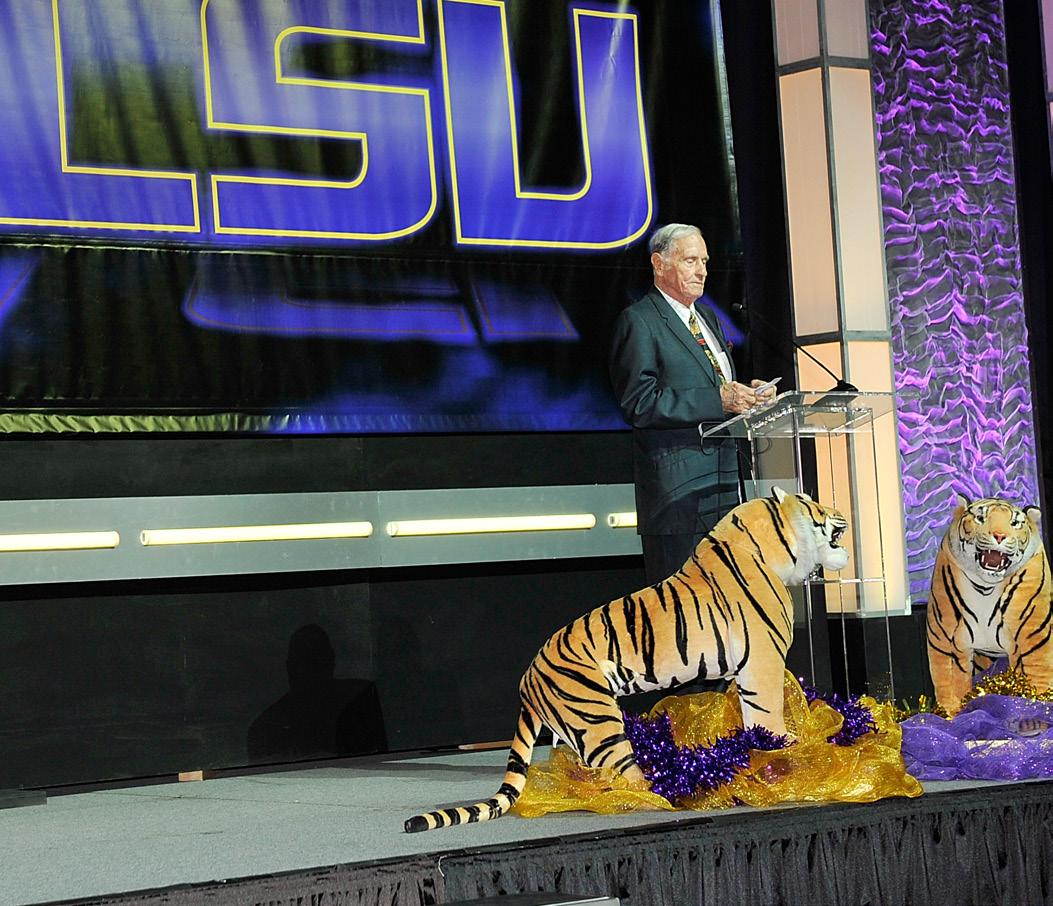
5 minute read
1953 FInal Four anniversary
(Front Row, l to r) Don Loughmiller, Darrell Schultz, Benny Mc Ardie, Norman Magee, Charley Robert (Second Row, l to r) Head Coach Harry Rabenhorst, Bill Lee, Leslie Jones, Don Belcher, Kenny Bridges, Assistant Coach John Chaney, (Back Row, l to r) Manager Fred Poerschke, James McNeilly, Bob Freshley, Bob Pettit, Ned Clark, Paul Braymen
1953 Final Four
60 YEARS LATER
It is time again to remember one of the great teams in LSU men’s basketball history and the stars who helped LSU to its first NCAA Final Four appearance, 60 years ago, in 1953.
Don’t remember 1953? Ike was president. Cokes were a nickel, movies a dime.
Now back in those days, the NCAA Tournament was this tournament that just 22 teams were invited to. LSU knew before the season was over it would be going to the tournament, knew where it would be going and knew it would play one of two teams in the second round after a firstround bye.
A Big Deal? Sure it was. As big a deal as today? In some ways, it’s your reflections of the time. The Final Four? That title wouldn’t even come about until the mid-1970s. The Associated Press called the semifinals and finals a “two-day showdown.”
But how did it happen? How did these Tigers make such a great run in 1953? How did they do it with a coach who was declared “too old to win?”
That was the petition of some LSU alumni to athletic director Thomas Heard that Harry Rabenhorst well, “Harry was too old” was how Heard told the story to New Orleans columnist Hap Glaudi. By the end of the season, Heard was telling Glaudi, “Why Harry’s been with us for something like 27 years and I know he ain’t too old to win.”
The Tigers were the favorites to win the SEC with Kentucky not eligible in 1953. But Rabenhorst was having nothing of it with the media. “Nothing’s certain but death and taxes.” But he did say that LSU had “a better than average ball club, although I don’t think we’re as good as people say.”
Rabenhorst was able to mold a perfect lineup from a young team to go with his lanky junior star Bob Pettit. He needed a smart fast guard and that came from Benny McArdle, who would be voted the league’s top playmaker. The forward Rabenhorst needed who could make outside shots was Don Belcher. Another big man who could play defense came in the form of Ned Clark and the other guard who could be a terrific driver and shooter was Norman Magee.
Other members of the team were Kenny Bridges, Bob Freshley, Don Loughmiller, Bill Lee, Jim McNeilly, Charlie Roberts, Darrell Schultz, Don Sebastien, Skip Jones and Paul Brayman.
The regular season was near perfection for the Tigers, going through the SEC undefeated. Even a spell of viral pneumonia that knocked 6-9 star Pettit out for several games couldn’t stop LSU as the




(Above) Harry Rabenhorst wasn’t “too old” to coach LSU to a Final Four. (Right) Bob Pettit accepts the MVP trophy at the 1952 Sugar Bowl Tournament in New Orleans.

Tigers continued winning.
Dan Hardesty wrote in the local paper: “The other Tigers may not be Pettits, but neither are they nice guys named Joe. They include several boys who might have been individual headliners if they had gone to another school. At LSU, they seem glad enough to be shock troops while big Bobby sets the records and that attitude toward the game is what has made a good team into a near-great one this year.”
It helped even more when defenses tried to shut down Pettit. “It was all right with me if they dropped two or three back on me,” Pettit said. “That means they left some of our guys open.”
Two games before the end of the regular season, an LSU 63-48 win over Ole Miss at the Cow Palace proved to lead to a laundry list of accomplishments – clinching the school’s first undisputed SEC championship, qualifying for the NCAA Tournament for the first time, extending the all-time school winning streak to 15 (it would reach 19 before it ended) and extended the team’s home winning streak to 22 straight games.
On the same night, Coach Harry Rabenhorst won his 300th game and junior Pettit reached 1,000 points, becoming at that time only the third to reach the lofty goal at LSU.
LSU would head to Raleigh, N.C., for its NCAA second round game (after a first round bye) and its opponent became clear when Lebanon Valley upset Fordham.
LSU would win, 89-76, and then have to face Holy Cross in the equivalent of the East Regional Final. The Tigers were just too much and won, 81-73. Pettit was named to the AllNCAA Eastern Regional Tournament team. In the game, Pettit would become the school’s all-time leading scorer and the first to top the 1,100 mark.
But the national semifinals in Kansas City would be the point where LSU would stumble. LSU ran into a buzz saw in Indiana, a team whose fast-paced style wore down the Tigers, who liked to play a slower paced game.
One night in Jan. 1993, the living members of the team came together again. The memories were as bright as the sun. They were back on the LSU Campus where it all began. They were honored with the rings they so deserved. For one night, 1953 seemed so fresh in the memory.














